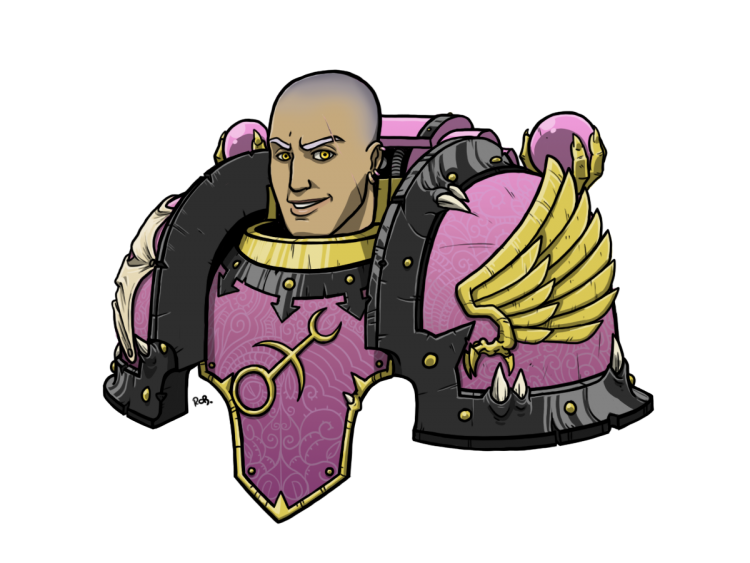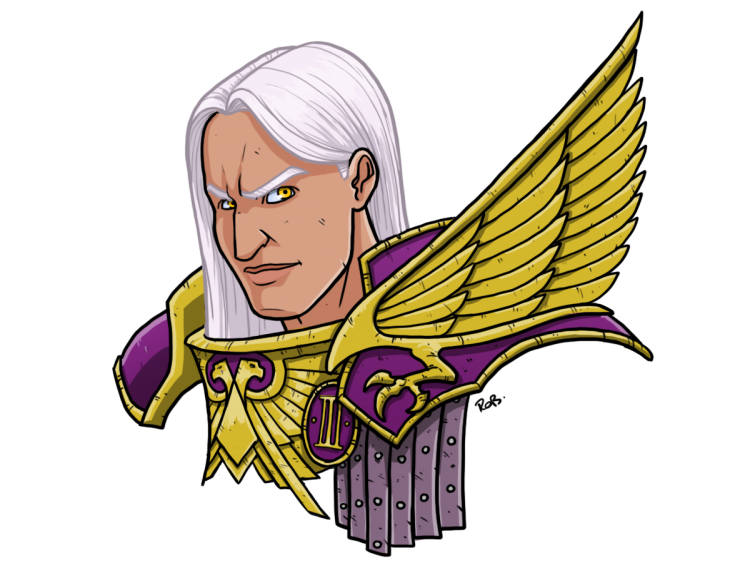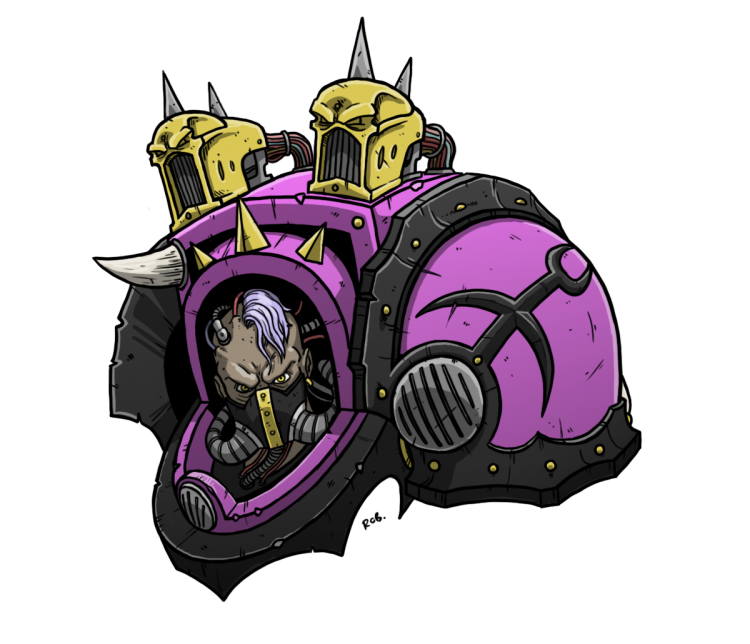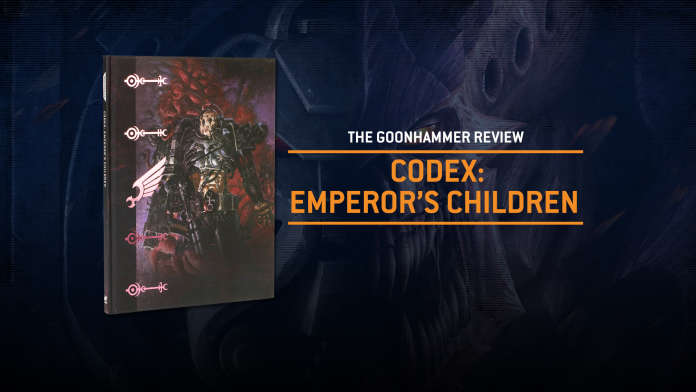Last weekend we previewed the rules in the new Codex: Emperor’s Children (you can find that review here), but despite talking about the rules for matched and narrative play, there’s still one major area left to talk about: The book’s lore. While most codexes released in tenth edition largely rehash and republish older lore from their eighth and ninth edition versions with some possible minor alterations – Codex Supplement: Dark Angels received the largest update with a two-page spread on the return of Lion El’Jonson and the creation of Wrymwood – the Emperor’s Children book gives us our first wholly new lore exploration of the edition. So it’s worth sitting down with the book to talk about what’s in it, what’s changed, and what’s cool about the Emperor’s Children lorewise in tenth edition.
As with the rules review, we’d like to thank Games Workshop for providing us with a preview copy of this book for review purposes.
Who Are the Emperor’s Children?
The Emperor’s Children are Slaanesh’s greatest mortal servants, the remnants of a first-founding legion of Space Marines who turned to the worship of Chaos during the Horus Heresy. To call them a legion now is being generous; they’re at best a fractured brotherhood, made up of many smaller warbands of superior warriors who raid and reave across the galaxy wearing garish colors in search of new sensations and vices.
Vices?
You heard right. The worship of Slaanesh has twisted the Emperor’s Children from imperious perfectionists into hedonistic madmen with a monomaniacal focus on experiencing new and extreme sensations. From pain and pleasure to denial and indulgence, these jaded warriors only respond to the most intense stimuli and so that’s what they seek out as they scour the galaxy for new things to see, taste, hear, and touch. This is reflected in their army rule – Thrill Seekers – which lets them move with unnatural speed but prevents them from charging or shooting an enemy unit which has already been picked as a target by an ally. They’re in it for new sensations and challenges and not so much teamwork.
This focus on new sensations makes the Emperor’s Children jaded as they live for thousands of years and so they’ve turned to biochemical alterations of their bodies and armor to heighten their reception to external stimuli. They make wide use of combat stimms and psychoactive drugs and poisons, often produced from the rendered bodies of their victims. The army’s Crusade rules focus in on this concept, giving you a set of rules that models the process of finding and distilling ingredients as you conquer worlds and mixing them into elixirs that can boost your units’ stats in battle.
All of this depravity would be a fun footnote if it weren’t for the fact that the Emperor’s Children were in fact the finest warriors of the Imperium before they turned to Chaos, and have continued to hone their skills in the millennia following. They relentlessly obsess over perfection in form and execution, and apply their pursuit of new sensations to the battlefield. Merely winning is not enough; they must humiliate their foe, leaving only carnage and howling victims in their wake. They’re consummate warriors and among the most lethal fighters in the galaxy.
![]()
The III Legion
The Emperor’s Children were one of the original First Founding legions of Space Marines, created by the Emperor to retake the galaxy. They were created in the likeness of their Primarch, Fulgrim, and under his guidance the legion were lauded as the exemplars of the Astartes, becoming the only legion entitled to bear the Palatine Aquila – the two-headed eagle symbol which served as the Emperor’s personal sigil – as their legion insignia. Fulgrim instilled in the legion a drive for excellence and perfection, and they’d seek to outdo and outperform their peers in the other legions. But eventually that drive would become perverted and twisted through a mix of daemonic influence, Xenos taint, and appeals from Horus, and Fulgrim’s corruption would spread and contaminate the rest of his legion. They sided with Horus in the Heresy and were among the legions in the assault on Terra. And like the rest of the traitor legions, they fled to the Eye of Terror following Horus’ defeat.
Sensational Warfare
One new aspect of the legion’s lore in the Codex is the section on how the Emperor’s Children conduct their planetary assaults. The first sign of their arrival is usually a barrage of sensation – this can be something like a bright display of biochemical agents that paint the sky in bright, toxic colors, or clouds of intoxicating and deadly musks, or cacophonous aural assaults that rupture eardrums, disrupt the weather, and drive citizenry mad. Then come the drop ships and gunboats, accompanied by daemonic sigils that cause nightmares in the populace. No two assaults are the same, and that’s a point of pride for the legion’s warbands, whose leaders see themselves as artisans of warfare delivering bespoke, small-batch atrocities tailored to each planet they visit. Each new world gets its own display of new obscenities dedicated to the glory of Slaanesh.
As the blood is spilled and sensations are gorged, the barriers separating the real world and the Immaterium break down, and before long the Emperor’s Children become lost in delirious pleasure. When this happens Daemons of Slaanesh can spill into the real world. Some of the legion see this is a sign of approval from their patron deity, a personal pat on the butt from She Who Thirsts. Some warbands are so into this they seek to make bargains with Daemons outright, bartering for forbidden knowledge and performing sacrifices to draw daemons into the mortal world to do battle along side their own mortal forces.

The Era Indomitus
The Emperor’s Children haven’t been a coherent force since the days of the Heresy. They’ve been split into hundreds of warbands, each focused on their own fight and led by an arrogant warlord. These leaders give themselves all manner of extravagant titles and surround themselves with sycophants and fawning admirers with no real influence, though some may encourage their underlings to advance, reveling in the excitement of having to avoid plots and schemes to unseat them. Regardless of how they operate, these warbands usually operate in smaller numbers than what you’d see for the Death Guard or Iron Warriors, who specialize more in the kind of grinding attrition that calls for bigger numbers. On top of that, the legion is full of conceited jerks with delusions of grandeur who are quick to think they could do a better job of things if they broke off and started their own warband.

Fulgrim
The Primarch of the Emperor’s Children remains one of the most feared warriors in the galaxy, though since his ascension to daemonhood he’s spent many long periods away from his sons. He’ll sometimes show up when he’s looking for a quick hit or when he’s summoned, but he’s still largely worshipped by his sons, most of whom adore and idolize him. Just being around the guy these days causes a visceral thrill in friends and foes alike, and some Emperor’s Children warbands actively seek him out, hoping to draw his eye so they can watch him just once do his terrible artistry on the battlefield.
Before he fell to Chaos, Fulgrim was a bit of a Renaissance man, taking an interest in not just combat and warfare but also music and the arts. He was capricious and volatile, and his desperate need for perfection and to better himself and his legion made him prideful. Ultimately that pride is what led him to turn traitor and into the worship of Slaanesh, at which point he turned on his brothers and killed his best friend Ferrus Manus, the primarch of the Iron Hands. He still wields Fireblade, the sword forged by Manus as a symbol of their brotherhood, though whether the sword is real or just a manifestation of Fulgrim’s subconscious is a subject of debate. Either way, any blade he wields is coated in deadly poisons that paralyze and kill.
Lucius the Eternal
The other notable character in the Emperor’s Children, Lucius was once an officer in the legion before the Heresy. He was a gifted warrior with a blade, and perpetually wanted to test his skills against the most skilled opponents. He’d eventually come to equate pain and victory in his mind, keeping the scars of his duels and etching new ones into his skin to commemorate new duel victories. When the Legion fell, Lucius began to seek out legendary fighters among both the loyalists and traitors, seeking out even tougher opponents.
Eventually he was killed in a duel by Lord Commander Cyrius, another warrior of the Emperor’s Children. Following the victory, over time Cyrius’ skin and armor began to change, and over time he transformed into Lucius, as the warrior became absorbed entirely by his defeated foe. Cyrius would be transformed into a screaming face on Lucius’ armor. And that just kept on happening – whenever Lucius would lose a duel, when his opponent showed the slightest satisfaction over having won, he’d begin to emerge from their flesh and armor, eventually overtaking them. This has happened a number of times, including once to a Necron cryptek after Lucius was killed by one of its automata. Slaanesh apparently just really likes watching the guy do his thing of talking a big game and getting murdered over and over. The most fun part is that each time he comes back he has to grapple with the idea that he can never actually beat the guy who killed him in a fight, something that enrages him.
For a guy whose whole deal is losing fights and coming back, Lucius takes his sword skills very seriously and he’s a pretty nasty fighter on the tabletop. He’s constantly looking to test himself against the most dangerous fighters in the galaxy, and each time he emerges from a former foe, they become a screaming, writhing face on his armor – the Armour of Shrieking Souls.

Quick Hits
The main lore of the Emperor’s Children in the Codex covers about ten pages detailing some notes on their history and touches on Fulgrim, followed by fourteen pages covering the individual units in the army. These tend to offer a paragraph or two on a unit type and its place within the hierarchy before moving on. I’ve compiled some quick notes on aspects that stand out here for reference.
- Lords Exultant are the Chaos Lord equivalent of the Emperor’s Children. They’re sadistic strategists who lead warbands into battle, and they’re a mix of ancient officers of the original legion who fought in the Heresy and newer aspirants who have fought their way up through the ranks. They wield warp-tainted blades and whips and may bind daemons to their will, felling them in battle.
- Daemon Princes represent the pinnacle of achievement for the mortals of the Emperor’s Children. The few warriors who can walk the Path to Glory to the very top are awarded with apotheosis, becoming immortal beings of the warp bound to Slaanesh.
- Sorcerers are seen as gifted and blessed in the Emperor’s Children, and appreciated for their ability to personally deliver horrifying visions into the minds of their foes.
- The Emperor’s Children are particularly horrified by Chaos Spawn, who they see as unable to properly process pleasure and pain, and who lack the ability to feel smug and superior to those around them. This is, of course, a fate worse than death.
- Flawless Blades are a new unit in the book, and get their own two-page spread. They see themselves as the greatest fighters in the warband (and probably the galaxy), and are obsessed with showing off in battle. Because they’re so arrogant, everyone else in the warband finds them to be off-putting jerks. In battle they call on daemonic patrons to give them power and witness their deeds, and in turn those patrons will sing appreciatively to their champions when they do well. If they fail to impress however, they’re torn apart by the daemonic forces they sought to use.
- Lords Kakophonist can detect mystical acoustic vibrations that are happening in the warp. They’re surgically enhanced even beyond Noise Marines.
- Noise Marines are the modern version of the Kakophoni of the original legion, warriors who’d wield sonic weapons into battle. Over time their senses have become warped and dulled, to the point where they can only sense the loudest and most discordant sounds.
- There’s a sick two-page spread in the book on Sonic Weapons that goes into how the four weapons – Screamer Pistols, Doom Sirens, Sonic Blasters, and Blastmasters – work.
- Tormentors tend to target weak spots in the enemy line with crazy accuracy while Infractors push ahead and expect the rest of the army to keep up with them. They’ll often range too far and outpace their coverage.
- There are twol pages devoted to the Daemons of Slaanesh, covering Keepers of Secrets, Daemonettes, Seekers, Fiends, and Shalaxi Helbane.
Final Thoughts
There’s some interesting new lore here on the Emperor’s Children and how they operate in the 41st millennium but what’s here also feels a bit threadbare. If you’re looking for more backstory on how the legion fell, the scouring of the Laer, or the Meraviglia, you’re not really going to find it here. There are a couple of references but on the whole this book is completely focused on what’s currently going on with the legion and not how they got here. The majority of new lore is focused on the new units in that regard and while it’s interesting, there’s not a ton here that you couldn’t have guessed just by looking at the models and knowing what the legion’s deal is. That’s a testament to the mini designers but it’s also a bit of a missed opportunity for the book’s lore sections.
Have any questions or feedback? Drop us a note in the comments below or email us at contact@goonhammer.com. Want articles like this linked in your inbox every Monday morning? Sign up for our newsletter. And don’t forget that you can support us on Patreon for backer rewards like early video content, Administratum access, an ad-free experience on our website and more.


